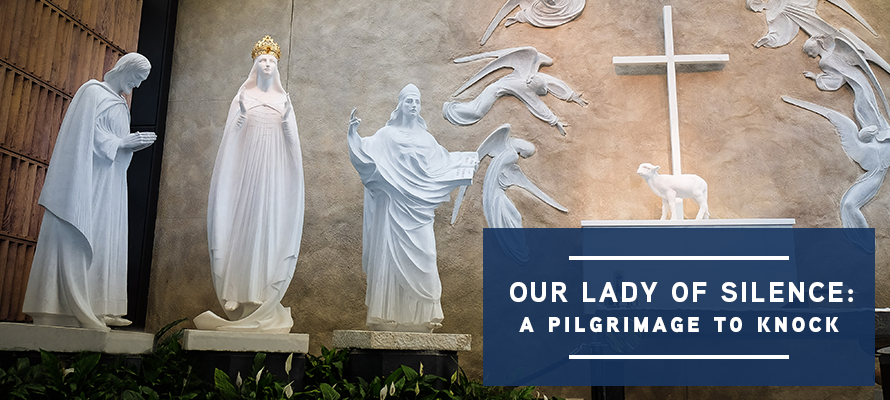
By Erin McCole Cupp
“Uncomfortable silence” is a phrase that has taken on multiple meanings of late. We can’t drive without the radio playing. We can’t sit anywhere without the buzzing of this text or that notification. We can’t even let our minds be quiet for more than thirty seconds before we pull out the smartphone and start looking for distraction. More recently, especially in the Church, silence has gotten a bad rap. Silence has become synonymous with not just avoiding offense but ignoring abuse and turning a blind eye to grave sin.
I had all of these thoughts on my mind when I arrived with my family at Knock Shrine. This shrine in in the west of Ireland was built on the site of an apparition in which Our Lady appeared, flanked by St. Joseph and St. John the Evangelist.
On the night of August 21, 1879, fifteen people ranging in age from five to nearly eighty years old were amazed at what appeared on the gable wall of the parish church. Three human figures stood beside a plain altar. On the altar was a lamb. Some of the visionaries saw a cross behind the lamb. All saw a beautiful light around the apparition, with figures of angels circling the lamb on the altar. The visionaries reported being so close to the figures that they could see the words in the book of the gospels that St. John held, but if any of the visionaries tried to touch the figures, they remained just out of reach.
Perhaps the most remarkable aspect of this apparition is that none of the visionaries heard a thing. The three human figures, the angel forms, the lamb—all were silent. While we know this apparition as Our Lady of Knock, the official title is “Our Lady of Silence.”
All fifteen witnesses’ accounts were investigated and found trustworthy. More and more pilgrims traveled to the site as news spread of illnesses cured through the intercession of Our Lady of Knock. As years passed and devotion to this apparition grew, the small parish church grounds expanded to include a basilica, chapels, rest homes for sick visitors, and even an airport to help pilgrims more easily reach this once-remote corner of County Mayo. Two popes have visited Knock.
The mystery posed by Our Lady of Silence has much for us to consider in our current cultural climate. Why did this tableau appear when it did? And why did it appear where it did? This was in the decades after Catholic emancipation in Ireland, after centuries of the Irish being silenced about their faith. Was Our Lady reminding the Irish people that God knew and valued the pain of their silence?
Our Lady appeared at Knock with St. Joseph and St. John the Evangelist, both protectors of Christ’s Mother. Knowing the new threats families would suffer in the following centuries, was God pointing out the duty of the family to foster and protect the Church? The lamb on the altar is a clear reminder of Christ’s sacrifice, the angels a reminder of His being worthy of our worship. Knowing that the liturgical changes of the Vatican Councils were coming, was Jesus emphasizing the importance of His sacrifice in the Mass?
On another level, did God want to give each of us individually an image for when our pain or guilt go beyond words? Was he emphasizing for us the simple present of presence? Was He showing solidarity with those who have been silenced for any reason, especially when crying out for mercy?
Silence poses more questions than answers. Perhaps, in today’s noisy, distracting environment, silence is the answer we need most. What things do we need that naturally tend towards silence? Healing. Penance. Meditation. Contemplation. Growth. All of these things make room for God’s Truth, and silence cannot be misused where Jesus is present.
For more about Our Lady of Silence, Knock Shrine has a very informative website. You can also learn more about pilgrimages to Ireland and other Marian shrines.
Our Lady of Silence, pray for us.
Erin McCole Cupp is a homeschooling Catholic mom and lay Dominican. While she lives in the Philadelphia countryside with her husband and three children, she is a Pilgrim at heart, always journeying closer to Christ and the Catholic faith.



